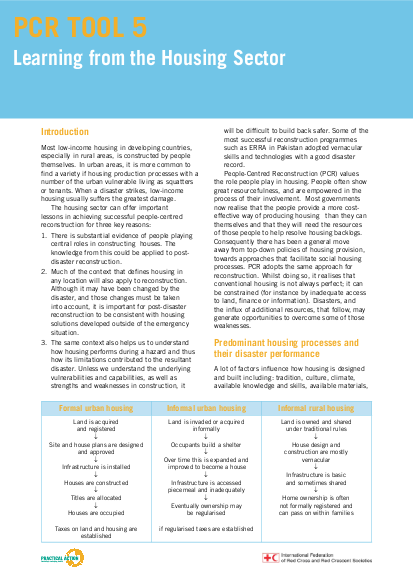
especially in rural areas, is constructed by people themselves. In urban areas, it is more common to find a variety if housing production processes with a number of the urban vulnerable living as squatters or tenants. When a disaster strikes, low-income housing usually suffers the greatest damage. The housing sector can offer important lessons in achieving successful people-centred reconstruction for three key reasons: 1. There is substantial evidence of people playing central roles in constructing houses. The knowledge from this could be applied to postdisaster reconstruction. 2. Much of the context that defines housing in any location will also apply to reconstruction. Although it may have been changed by the disaster, and those changes must be taken into account, it is important for post-disaster reconstruction to be consistent with housing solutions developed outside of the emergency situation. 3. The same context also helps us to understand how housing performs during a hazard and thus how its limitations contributed to the resultant disaster. Unless we understand the underlying vulnerabilities and capabilities, as well as strengths and weaknesses in construction, it will be difficult to build back safer. Some of the most successful reconstruction programmes such as ERRA in Pakistan adopted vernacular skills and technologies with a good disaster record. People-Centred Reconstruction (PCR) values the role people play in housing. People often show great resourcefulness, and are empowered in the process of their involvement. Most governments now realise that the people provide a more costeffective way of producing housing than they can themselves and that they will need the resources of those people to help resolve housing backlogs. Consequently there has been a general move away from top-down policies of housing provision, towards approaches that facilitate social housing processes. PCR adopts the same approach for reconstruction. Whilst doing so, it realises that conventional housing is not always perfect; it can be constrained (for instance by inadequate access to land, finance or information). Disasters, and the influx of additional resources, that follow, may generate opportunities to overcome some of those weaknesses.
Resource collections
- Accountability to affected populations (AAP)
- ALNAP focus topics
- Evaluating humanitarian action
- UN Habitat - Urban Response Collection
- Urban Response - Urban Crisis Preparedness and Risk Reduction
- Urban Response Collection - Community Engagement and Social Cohesion
- Urban Response Collection - Economic Recovery
- Urban Response Collection - Environment and Climate Change
- Urban Response Collection - Housing, Land and Property
- Urban Response Collection - Urban Crisis Response, Recovery and Reconstruction
- Urban Response Collection - Urban Resilience